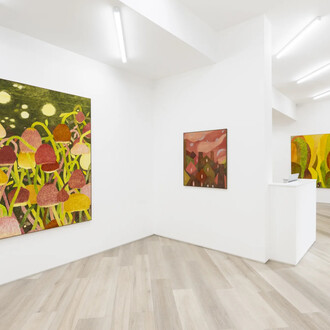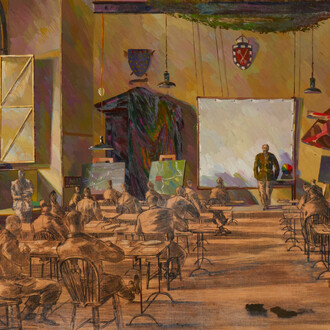Contemporary Visions V is Beers Contemporary's fifth annual open-call group exhibition. This year, nearly 2,000 applicants were adjudicated by Amanda Coulson (Artistic Director of VOLTA New York/Basel); Paul Carter-Robinson (Editor Artlyst); Kurt Beers (Director of Beers Contemporary, Author of 100 Painters of Tomorrow); as well as previous exhibitor, artist Phil Woodward.
Since its inception, the Contemporary Visions group exhibition has sought to identify current trends in contemporary art through the discovery of exciting emerging artists working across all artistic disciplines. The fifth instalment presents nine international artists who stretch the limits of their practice to create works that are playfully abstract, invariably bright, with a distinctive, almost acerbic energy. Together, they create a vision of contemporary art that is both unique and referential, quoting from an art historical language and disciplines to reinterpret and reinvent their chosen media.
Austin Ballard’s organic sculptural forms, like concrete coral forms are tempered by the inclusion of metal and carpentry – as well as a severity of materiality. Here, the corporeal tactility of Ballard’s organic form (like some candy-colored Rebecca Warren cast-off) interlocks intimately, contradictorily, with a barely-visible pane of glass, creating a subtle tension between the materials, poised delicately on tip-toe. Like many works on exhibit, one sees a dialogue that playfully mimics the manmade structure and the natural landscape. Throughout Ballard’s practice, Ballard’s sculptures often appear to defy gravity, precariously dangling on one edge of a surface, plinth or clay foot; certainly a further reminder of the fragile and perilous relationships created both in – and out – of studio…a grand metaphor for our social interactions, perhaps?
Similarly, Luke Armitstead's ceramics interact with their surrounding space by playfully questioning their status as objects of 'use' or 'decoration'. These colourful, geometrically-charged forms often take the shape of deconstructed architectural models, appropriating the shapes of funky planters, tribal masks, or even a 1980s punk-aesthetic: the ‘figure’ in Caught & Twisted even has a barely-there ‘ear piercing’. From here we are asked to consider Oliver Hickmet’s work, (the installation seen here inspired by the kitsch of travel brochures,) which explores a relationship between truth and artifice through painting, sculpture, even video, to investigate the role that the 'image' plays in forming a globalised culture and language. His practice invites us to question discrepancies that exist in any aesthetic dialogue, as well as in contemporary society more generally, and the highly mediated experiences of life we have become so used to consuming. Max Olofsson reaffirms this: his 'digital paintings' use a universal pixelated language to create a pastiche of visual clichés. His digital-photograph-paintings thus reverse the relationship between ‘original’ and ‘documentation’ to relinquish the very concept of being limited to (or inhibited by) a single artistic medium or method of display or hierarchical mode of expression (where cartoon eyeballs meet ‘high art’). These are artists actively challenging the barrier between real and imagined, high and low, fine art and hobby: such a challenging of form and content has never felt so topical.
Felicity Hammond’s photographic compositions – like monumental explorations in nature versus that of a digital world - explore the constant construction and destruction of the urban environment. She is keen to remind us of its artifice: her most recent series depicts the transformative landscape of East London – depicted here as a apocalyptic-cum-utopian wasteland – seems like an updated tribute to Venetian scenic painting, is steeped in an unearthly cobalt hue: a color scientifically proven to trigger cognitive pleasure. Together these still images feel charged, as though reverberating with the movement of unearthly urban decay. The entire composition questioning the authority of photography to depict reality – or, its ability to manipulate the viewer into interpreting it with veracity and verisimilitude.
Jonny Green performs a similar ruse: first composing small maquettes, the artist then painstakingly repaints these still-lives (or are they figurative paintings) with oil on canvas. The resulting hyper-real paintings depict crudely rendered Play-Doh monsters, decked out in dollar-store Christmas lights, paper flowers and decommissioned clock parts. But what is hyper-real when the subject itself is not ‘real’? Here we believe the artist as omniscient. But we are reminded that we are viewing a carefully recreated scene, a painter's scarecrow, meant to trick us into believing the silliness and its veracity like a type of representational mise-en-abyme. True, they are hyperreal, but to what extent, if the very imagery they depict is itself so detached from reality? Jose Carlos Naranjo Bernal, the only other representational painter here, finds a breakdown of reality through mark-making, where subject matter seems incidental, almost as an afterthought to their framing within the painted plane: where elements of urbanity (a chainlike fence, for instance) becomes a purely aesthetic pattern. Where a blue-black silhouette leads us to read such a mark as a figurative painting?
Alan Sastre’s paintings, for instance, don't feel like paintings at all. Awash in psychedelic hues and a determined working (and reworking) of their surface texture, where wide brushwork and the attention to their topographic nature belies such a miniature scale. These small tokens seem like leftovers of cyber-reality; almost jewel-like, radioactive remnants that seem to buzz and hum with an unearthly glow. Neither fully painterly nor fully sculptural, they sit paradoxically between states. Comparatively, Peter Baader's paintings refute entry, pushing viewers away from the illusion of infinite space and establishing their flatness and artifice. As a result, his canvases – like Sastre’s - become ambiguous, as though both referentially laden and void, where we are viewing an expanded field of sorts, an abstract reality of the artists own imagination. In fact, this is where each of the artist’s finds their link to the other – not through their hyper color-schemes or playful disposition, but through ideas of recognition and interpretation. So what is a true ‘Contemporary Vision’? Perhaps, these artists suggest, the ability to inspire beyond the limits of our perception of reality, to question through form, content, and function, and blur lines between the real and the imagined?



















